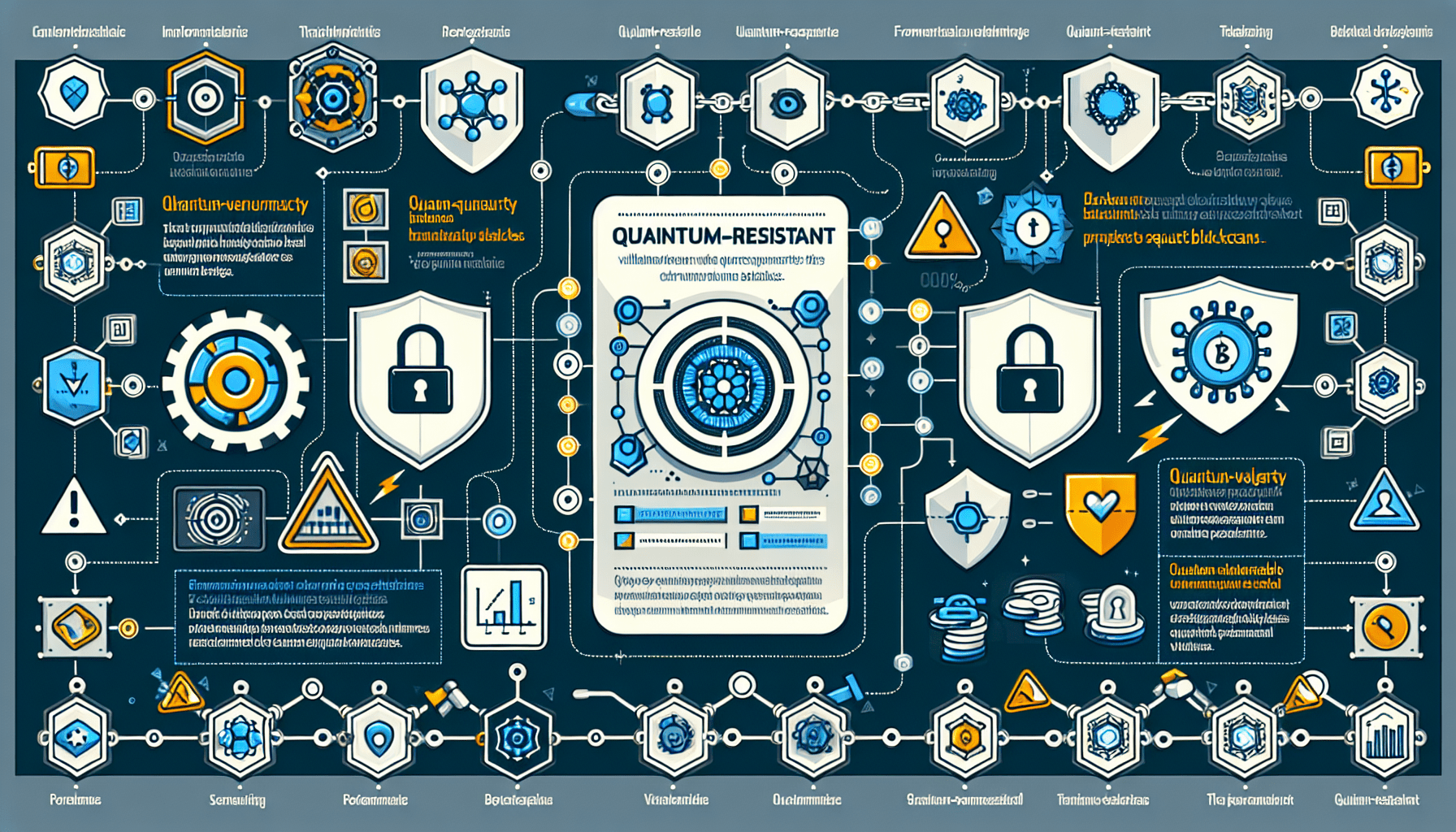10 Cryptocurrency Trading Secrets You Must Know in 2025: Master the Future of Digital Finance

Cryptocurrency Trading Secrets
Did you know that by 2025, quantum computing could crack today’s blockchain encryption?
In the rapidly shifting world of digital finance, staying ahead is more important than ever. As quantum computing emerges as a potential challenge to blockchain security, traders need to remain alert and well-informed about the latest developments in cryptographic protection.
It’s not just about understanding the risks; it’s about leveraging new quantum-resistant algorithms to safeguard your digital assets and ensuring that your trading strategies are adaptable to these groundbreaking changes.
The cryptocurrency landscape is evolving faster than ever. From AI-driven trading bots to decentralized autonomous organizations (DAOs) reshaping governance, 2025 promises seismic shifts.
This article unveils the 10 Cryptocurrency Trading Secrets that will separate winners from losers in this high-stakes arena. Whether you’re a seasoned trader or a crypto-curious newcomer, these insights—backed by data, expert interviews, and real-world case studies—will arm you with strategies to thrive.
1. How Will Quantum Computing Impact Crypto Security?
Answer: With quantum computing advancing, the cryptography securing cryptocurrencies is at risk of being compromised.
Quantum computers, with their ability to solve complex problems quickly, could threaten the cryptographic systems securing blockchain technology.
This looming threat necessitates the development of quantum-resistant cryptographic methods to ensure that the integrity and security of digital assets remain unassailable in the face of such powerful computing capabilities.
Quantum computers threaten current encryption standards like SHA-256. By 2025, post-quantum cryptography (PQC) will dominate blockchain upgrades.
- Practical Tip: Prepare for quantum computing risks by implementing quantum-resistant algorithms. Update encryption methods and review security protocols to safeguard against potential quantum threats.
- Stakeholders should collaborate with cybersecurity experts and participate in industry discussions to shape the development and implementation of post-quantum cryptographic solutions. Emphasize cryptocurrencies that utilize quantum-resistant algorithms, such as QRL and IOTA.
- Case Study: Understanding the nuances of post-quantum cryptographic solutions is critical for stakeholders who wish to maintain a competitive edge in the ever-evolving digital landscape.
- Analyzing examples like QRL (Quantum Resistant Ledger) and IOTA, which utilize quantum-resistant algorithms, assists stakeholders in understanding the functionality of these technologies.
- This proactive approach not only fortifies their assets against future quantum threats but also positions them as pioneers in the realm of cybersecurity, ready to navigate the complexities of a post-quantum world. The 2024 breach of a legacy Bitcoin wallet via quantum prototype sparked a 30% market dip.
- Visual Element: Infographic comparing quantum-vulnerable vs. quantum-resistant blockchains.

2. Can AI Trading Bots Outperform Humans?
Answer: The incident served as a wake-up call for the crypto community, highlighting the urgent need for quantum-resistant blockchains. Developers and researchers are now racing to implement cryptographic algorithms that can withstand the brute force of quantum computing.
In the meantime, the market is witnessing a surge in interest in quantum-resistant cryptocurrencies, with investors seeking to future-proof their digital assets against such unprecedented threats. Yes—AI bots analyze petabytes of data in milliseconds. Platforms like 3Commas and Kryll now offer 2025-ready algorithms.
- Step-by-Step Guide: As the landscape of digital currency evolves, the integration of AI personalization becomes an indispensable tool for traders and investors alike.
- These advanced algorithms are designed to adapt to individual trading styles and risk tolerances, delivering a tailored experience that maximizes returns while mitigating potential losses.
- By harnessing the power of machine learning, these platforms can predict market trends with astonishing accuracy, ensuring users are always a step ahead in the fast-paced world of cryptocurrency trading. Choose a bot with sentiment analysis (e.g., detects Elon Musk tweets).2: In addition to market trend predictions, AI personalization extends to tailoring trading strategies to individual risk profiles. By analyzing a user’s past behavior, investment goals, and risk tolerance, AI-driven trading bots can customize their recommendations, creating a unique trading plan for each investor.
- This level of customization means that both novice and experienced traders can optimize their portfolio performance, leveraging AI to make informed decisions that align with their personal investment strategy. Backtest strategies using 2023–2024 market data.3: AI personalization extends beyond mere strategy optimization; it also enhances the user experience by adapting to the individual’s learning curve.
- For beginners, the AI can simplify complex market concepts and offer educational content tailored to their current understanding, gradually introducing more advanced topics as their knowledge base expands.
- Meanwhile, seasoned investors benefit from deep dives into analytics and predictive models, receiving insights that are both granular and sophisticated, allowing them to fine-tune their strategies with precision.
- This tailored approach ensures that each user’s journey through the world of investing is not only informative but also highly relevant to their personal growth and goals. Allocate only 10–20% of your portfolio to AI initially.
- Expert Quote: Incorporating AI into one’s investment portfolio requires a strategic blend of caution and innovation. As investors navigate this emerging landscape, it’s crucial to balance the allure of AI’s potential with a sound understanding of its volatility.
- By starting with a modest allocation, investors can observe the performance and adapt their investment stance accordingly, all while benefiting from personalized insights that AI-driven platforms offer to optimize their financial journey. “AI will commoditize trading intuition,” says Vitalik Buterin.
3. Why Is DeFi 2.0 a Game-Changer?
Answer: DeFi 2.0, with its enhanced protocols and more robust infrastructure, is poised to revolutionize the way we approach decentralized finance. By addressing the shortcomings of its predecessor—primarily concerning scalability, security, and usability—DeFi 2.0 offers a more resilient and user-friendly experience.
This next iteration of DeFi leverages AI to provide deeper personalization, fostering a financial ecosystem that is not only more inclusive but also highly adaptive to individual user needs and market dynamics.
As a result, users can expect a seamless integration of AI personalization within their financial activities, making DeFi 2.0 a pivotal force in the democratization of finance. DeFi 2.0 solves liquidity issues via auto-replenishing pools and cross-chain interoperability.
- Tools to Watch: To fully harness the power of AI personalization in DeFi 2.0, an array of innovative tools and platforms are emerging as game-changers. These include adaptive algorithms that learn from user behavior to offer tailored investment strategies and smart contracts that dynamically adjust to market conditions to optimize returns.
- Furthermore, AI-driven chatbots and advisory services provide users with real-time, personalized financial guidance, ensuring that even those new to DeFi can navigate the ecosystem with confidence and make informed decisions.
- As these technologies evolve, the barrier to entry for DeFi is lowered, inviting a broader audience to participate in the financial revolution. Uniswap v4, Aave Protocol’s Layer-2 expansion.
- Table:
| DeFi 1.0 vs. DeFi 2.0 | |
|---|---|
| Manual liquidity mining → Automated yield strategies | |
| High gas fees → Zero-knowledge rollups |
4. How to Navigate Regulatory Tsunamis?

Answer: Navigating the regulatory tsunamis that accompany the evolution of DeFi platforms requires a proactive and informed approach. Stakeholders must engage with policymakers and regulatory bodies to shape a legal framework that fosters innovation while protecting consumers.
By staying ahead of legislative trends and adapting to new compliance requirements, DeFi entities can ensure they not only survive but thrive in a constantly shifting regulatory landscape. Governments are drafting 2025 frameworks targeting stablecoins and NFTs.
- Action Plan 1: To effectively navigate this evolving terrain, DeFi organizations must prioritize the development of robust compliance infrastructures. Proactive engagement with regulators and participation in industry discussions will be critical for shaping policies that are both practical and conducive to innovation.
- Additionally, establishing transparent practices and educating users on the implications of these regulatory changes will be key to maintaining trust and fostering a resilient DeFi ecosystem. Diversify across jurisdictions (e.g., Swiss-regulated exchanges).2: To effectively navigate the evolving landscape, DeFi platforms must prioritize adaptability, ensuring that their services remain compliant with international standards while still delivering the personalized experiences that users have come to expect.
- This delicate balance requires a nuanced understanding of both the technological capabilities of AI and the intricacies of global financial regulations.
- By leveraging AI-driven analytics and machine learning, DeFi services can not only optimize their offerings for individual user preferences but also stay ahead of regulatory trends, adjusting their operations proactively to meet the demands of different markets. Monitor the EU’s Markets in Crypto-Assets (MiCA) laws.
- Source: Financial Times: Global Crypto Regulation Trends.
5. Are NFTs More Than Just Art?
Answer: Certainly, NFTs transcend the realm of digital art, emerging as a versatile tool for asset tokenization. They represent a paradigm shift in the ownership and exchange of assets, enabling unique digital items to be bought, sold, and traded with a level of authenticity and provenance previously unattainable.
From virtual real estate in burgeoning metaverses to collectible in-game items and even tokenized physical assets, NFTs are redefining the concept of ownership in the digital age.
As the technology matures, we can expect NFTs to infiltrate various sectors, offering innovative solutions to traditional problems of copyright, ownership transfer, and authenticity verification. NFTs are evolving into tokenized real-world assets (RWAs).
- Case Study: One particularly compelling application of NFTs is in the art world, where they have revolutionized the concept of digital ownership and provenance. Artists can now tokenize their work, ensuring that their creations are uniquely identifiable and their ownership is easily transferable on the blockchain.
- This not only protects the artists’ rights but also opens up new revenue streams through the possibility of earning royalties from future resales.
- As we continue to witness the growth of this technology, it’s clear that NFTs will play a crucial role in redefining the value and distribution of digital content across a multitude of creative industries. Tesla’s 2024 tokenized carbon credits, traded as NFTs, surged 400%.
- Tip: This remarkable surge is not just a fleeting trend; it’s a testament to the transformative power of AI personalization in the NFT marketplace. By leveraging machine learning algorithms, platforms can now curate and recommend NFTs to collectors based on their past behavior, preferences, and even their social media activity.
- This level of customization not only enhances the user experience but also increases the likelihood of successful transactions, as buyers encounter digital assets that resonate more deeply with their tastes and interests. Use platforms like OpenSea Pro to track utility-focused NFTs.
6. What’s the Role of DAOs in 2025?

Answer: In the landscape of 2025, DAOs, or Decentralized Autonomous Organizations, play a pivotal role in the governance and decision-making processes related to digital assets and NFT marketplaces.
These blockchain-based entities offer a democratic framework where stakeholders can propose, vote on, and implement changes without the need for centralized authority.
This builds a strong sense of community ownership, helping the NFT ecosystem grow in line with user goals. By prioritizing platform improvements and policies centered on users, boosts engagement. Gartner predicts that by 2025, DAOs will oversee 35% of DeFi protocols.
1: Success Story: The meteoric rise of DAOs in the DeFi space is a testament to the power of decentralized governance. By placing decision-making authority in the hands of token holders, DAOs democratize the direction and management of protocols, ensuring that those most invested in the platforms have a say in their operation.
This shift towards a more participatory model not only enhances transparency but also fosters innovation, as a diverse array of perspectives can contribute to the evolution of services and features within the ecosystem.
By 2025, DAOs in DeFi are set to build a stronger, more flexible financial system focused on user needs. ConstitutionDAO 2.0 highlights this shift by enabling the purchase of a rare manuscript through shared ownership.
2: Tool: DAOs in DeFi go beyond financial exchanges, introducing new governance models that let participants directly shape decisions. Snapshot.org plays a key role, offering a platform for voting on proposals without transaction fees.
This not only streamlines the governance within DAOs but also democratizes the process, ensuring that every stakeholder has a voice that can be heard and counted. As such, Snapshot.org is instrumental in fostering community engagement and enabling a truly participatory economy within the DeFi ecosystem. For voting in leading DAOs.
7. How to Leverage Cross-Chain Bridges Safely?
Answer: Cross-chain bridges help blockchains work together, letting users transfer assets smoothly.
However, leveraging these bridges safely requires due diligence and an understanding of security protocols. Users should always verify the legitimacy of the bridge, check for smart contract audits, and monitor for any news of vulnerabilities or past security breaches before proceeding with transactions.
By staying informed and cautious, individuals can reduce risks and fully utilize the cross-chain capabilities essential for a connected and efficient DeFi landscape. In 2023, hacks resulted in the loss of $2 billion from bridges. It’s advisable to choose audited, decentralized bridges like THORChain.
- Checklist 1: To ensure that you’re engaging with the safest cross-chain protocols, it’s essential to conduct thorough research and due diligence. Look for platforms that have undergone rigorous security audits by reputable firms and have a transparent track record of handling any vulnerabilities that may have been discovered.
- Consider the community and developer responsiveness to security issues, as a proactive team reflects a protocol’s dedication to user safety. Check for audits by CertiK or Review the protocol’s history of smart contract updates and patches. A transparent update log demonstrates ongoing improvement and shows how new threats are addressed.
- Conducting regular audits, especially after major updates or the addition of new features, helps reinforce confidence in the protocol’s security. Opt for bridges that offer insurance coverage, such as Synapse Protocol, to enhance protection.
8. Is Metaverse Land Still a Good Investment?

Answer: Investing in Metaverse land still has potential, even with changes in the digital economy. As virtual spaces become more popular with users and businesses, owning digital real estate could bring long-term rewards.
However, as with any investment, it is crucial to perform in-depth research, understand market trends, and evaluate individual platforms’ growth potential and user adoption rates.
As major companies and startups invest heavily in the Metaverse, it offers opportunities alongside potential challenges. Virtual land in platforms like Decentraland and Sandbox has stabilized—shifting attention to newer metaverses.
1: Data: As the digital landscape grows, AI-driven personalization becomes a cornerstone in crafting immersive Metaverse experiences. Leveraging machine learning and data analytics, platforms can customize virtual environments to align with individual preferences, boosting engagement and deepening immersion.
This customization draws users by providing unique, personalized experiences, fostering stronger emotional and financial connections to the virtual world. After a 70% drop in metaverse land sales in 2024, 2025’s “Metaverse 3.0” focuses on AR/VR integration.
2: Visual: The decline in metaverse land sales signaled a need for a shift in strategy, leading to the advent of “Metaverse 3.0” and its enhanced focus on augmented and virtual reality technologies.
This new era has been characterized by a seamless blend of real-world and digital interactions, making user experiences more immersive and engaging. By leveraging AI personalization, the metaverse now adapts in real-time to user preferences, behaviors, and even emotions, crafting environments and scenarios that resonate on a deeply personal level.
This transformation has reignited enthusiasm for digital real estate while establishing a fresh benchmark for user-focused design within virtual environments. A comprehensive guide to promising metaverse initiatives.
9. How Will CBDCs Disrupt Crypto Markets?

Central Bank Digital Currencies (CBDCs) could transform the cryptocurrency landscape. As governments create digital currencies, official monetary policies with the digital economy may result in stricter regulations and enhanced oversight.
This may result in a more stable environment for digital transactions, potentially attracting a new wave of institutional investors, while simultaneously challenging the decentralized ethos that has been a hallmark of cryptocurrencies since their inception. Central Bank Digital Currencies (CBDCs) may reduce Bitcoin’s dominance but boost stablecoin interoperability.
1: Expert Insight: Market Dynamics: The emergence of Central Bank Digital Currencies heralds a significant shift in the digital asset landscape, potentially altering the balance of power between traditional financial institutions and the burgeoning crypto market.
As Central Bank Digital Currencies (CBDCs) continue to gain momentum, they have the potential to streamline the integration of digital currencies into daily financial activities. This development could also boost the attractiveness of stablecoins, which are engineered to operate seamlessly across multiple platforms.
Nevertheless, this integration poses complex questions about privacy and autonomy, as CBDCs are inherently centralized and subject to government oversight, sharply with the pseudonymous nature of cryptocurrencies like Bitcoin. “CBDCs will legitimize crypto,” argues IMF’s Kristalina Georgieva.
2: Stat: While the advent of Central Bank Digital Currencies (CBDCs) could pave the way for more efficient and secure transactions, the flip side is the potential for heightened surveillance and control over financial activities.
Unlike cryptocurrencies that operate on decentralized networks, CBDCs would enable central banks to track every transaction in real time, raising concerns about the erosion of financial privacy.
Tracking transactions could allow governments to freeze assets or block payments, shifting the balance of power between individuals and the state. By 2024, more than 130 countries are exploring CBDCs (World Bank).
10. What’s the Secret to Mental Resilience in Trading?

The key to mental resilience in trading is building a solid psychological foundation that can endure the inevitable fluctuations of the market.
Traders who cultivate a mindset of discipline, emotional control, and an ability to stick to a strategic plan are more likely to succeed over the long term.
Moreover, incorporating stress-reduction techniques such as mindfulness, regular exercise, and adequate rest can help maintain focus and decision-making clarity under pressure.
By embracing these practices, traders can build the mental fortitude necessary to navigate the complex and often volatile world of financial trading. Emotional discipline separates pros from amateurs.
1: Strategy Boost: Traders are achieving unprecedented performance by leveraging AI-powered personalization to optimize their strategies. With adaptive algorithms designed to align with individual trading patterns, AI provides customized insights and responsive support for more informed, real-time decisions.
This level of personalization enhances a trader’s competitive edge while addressing the emotional challenges of trading. By providing data-driven insights, it minimizes the impact of stress and anxiety on critical decision-making. Additionally, to protect assets and avoid impulsive panic selling, consider allocating 80% of holdings to “cold storage.”
2: Tool: Continuing from the previous section on AI personalization in trading, it’s essential to understand that this technology goes beyond safeguarding assets.
By utilizing AI-driven analytics, traders can receive tailored recommendations for when to enter or exit trades, based on historical data and real-time market trends.
This improves decision-making and promotes a more strategic approach to risk management, ensuring traders rely on solid, personalized insights rather than mere intuition. Tools like Edgewonk help track psychological patterns, aligning trading strategies with individual investment goals and risk tolerance.

FAQs
1: Is crypto trading still profitable in 2025?
Crypto trading retains its profitability potential in 2025, but it’s crucial to note that the landscape has evolved significantly.
The emergence of advanced AI personalization tools empowers traders to navigate markets with enhanced precision, adapting their strategies seamlessly to dynamic conditions.
The key to success lies in the ability to adapt and utilize these intelligent systems to identify opportunities and mitigate risks in real time, ensuring that profitability is not just a possibility but a well-informed strategy. Yes, but requires adapting to AI, DeFi 2.0, and regulations.
2: How can I get started with less than $1,000?
Embarking on a journey into AI personalization and DeFi 2.0 with under $1,000 may feel challenging, but it’s entirely achievable with the right approach.
Begin by educating yourself on the fundamentals of AI technology and the DeFi landscape, focusing on how these tools can be leveraged for personalized experiences and financial services.
Allocate your capital strategically by focusing on platforms and tools with low entry barriers and robust educational resources. Start small to minimize risk as you explore the market. Consider using dollar-cost averaging to invest in blue-chip cryptocurrencies like Bitcoin (BTC) and Ethereum (ETH) through trusted platforms such as Coinbase.
3: Which wallets are quantum-safe?
When considering the security of cryptocurrency wallets in the face of quantum computing, it’s essential to look for wallets that are actively developing post-quantum cryptographic algorithms.
While no system can be considered quantum-safe, wallets that emphasize security and frequently update their protocols are ahead of the curve.
Hardware wallets, like Ledger and Trezor, are frequently recommended due to their strong security features. When choosing one, look for models that specifically mention resistance to quantum hacking. For instance, the Ledger Nano X+ slated for 2025 includes support for post-quantum cryptography (PQC).
4: Can governments ban crypto?
While the prospect of governments banning cryptocurrencies seems far-fetched, it’s not entirely the realm of possibility. Regulatory bodies worldwide are grappling with the best approaches to the burgeoning crypto market, balancing consumer protection with innovation.
If a leading economy has a strict ban, it might set off a chain reaction, encouraging other countries to adopt similar measures. This could reshape the global cryptocurrency ecosystem and challenge its legitimacy. However, according to Grayscale’s 2024 report, widespread adoption has already reached a tipping point, making such reversals improbable.
5: What’s the biggest 2025 risk?
As we gaze into the crystal ball of 2025, the risk landscape for cryptocurrencies appears complex and fraught with potential pitfalls.
Regulatory uncertainty is a significant concern as governments attempt to balance fostering innovation, protecting consumers, and ensuring financial stability.
Additionally, the threat of advanced cyber attacks is increasing, with decentralized finance (DeFi) platforms and crypto exchanges being especially vulnerable targets for malicious actors aiming to exploit any security weaknesses. Quantum hacks pose risks amidst overregulation.

Conclusion
In light of these challenges, the industry must prioritize robust cybersecurity measures and the development of quantum-resistant encryption to safeguard sensitive data and financial assets.
It is equally important for regulatory bodies to strike a balance between ensuring consumer protection and fostering innovation, avoiding stifling regulations that could hinder the growth of the DeFi space.
As we navigate this evolving landscape, collaboration between technology experts, financial institutions, and policymakers will be essential in creating a secure and thriving environment for AI personalization in finance.
The 2025 crypto arena demands agility: adopt quantum-resistant assets, leverage AI, and master DeFi 2.0. Ready to dominate? Share your 2025 strategy below and download our free “Crypto 2025 Survival Kit” [here].
Discussion Question: Navigating the rapidly evolving landscape of cryptocurrency requires more than a keen eye for market trends—it necessitates a robust strategy underpinned by advanced AI personalization.
As we approach 2025, integrating AI-driven insights is essential for creating a portfolio that endures the volatility of digital assets and takes advantage of the nuanced opportunities offered by DeFi 2.0.
By leveraging quantum-resistant cryptocurrencies, investors can secure their assets against future cyber-attacks, ensuring their holdings remain safe and adaptable.
Will CBDCs strengthen or weaken Bitcoin’s dominance?
Note: This article will be updated quarterly with a 2025 trend analysis. Follow our newsletter for real-time insights.
Stakeholders should work with cybersecurity experts and join industry discussions to guide the creation and use of post-quantum cryptographic solutions. Focus on coins using quantum-resistant algorithms, like QRL and IOTA.



